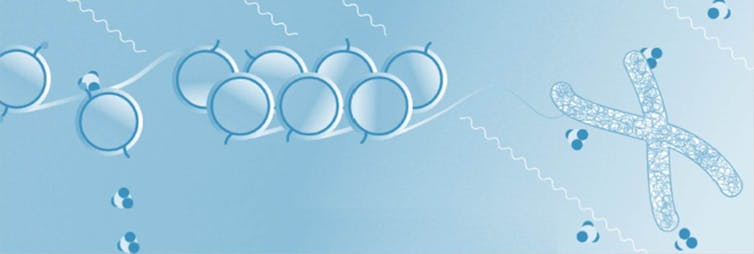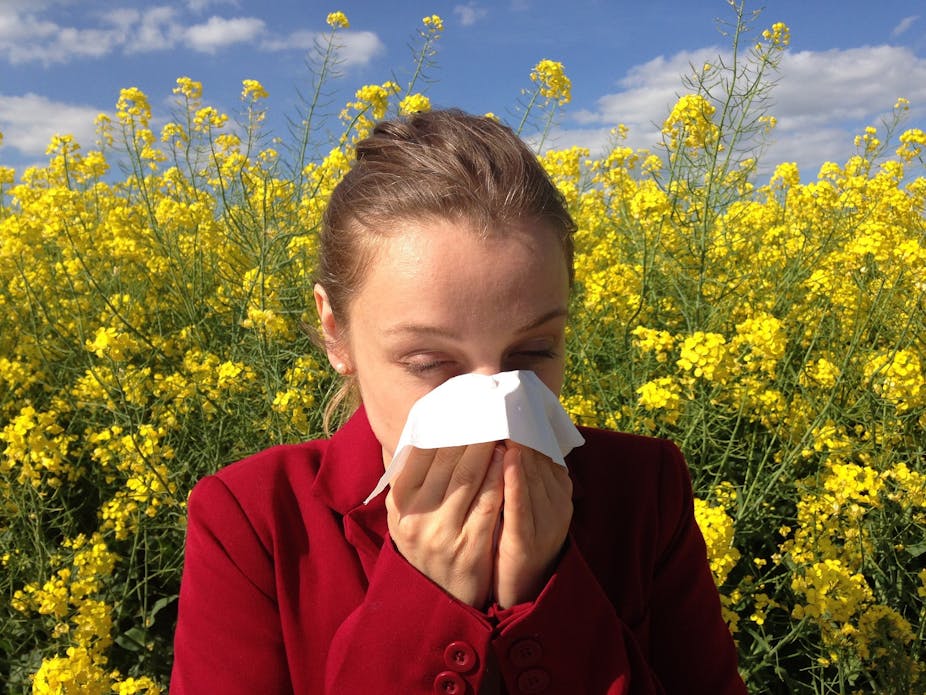Is this the worst Northern Hemisphere allergy season yet? For many people – both those who’ve suffered before and newcomers to the annual sniffling, coughing mess that accompanies springtime – it seems like there are more allergens and allergies today than ever before.
They’re not really wrong: allergic diseases are on the rise in the Northern Hemisphere. Nearly one in every two Europeans has either a food or environmental allergy, and both have increased in frequency and severity over the last decade.
Many allergies start in childhood. According to the European Federation of Allergy and Airway Diseases Patients Association around 65% of children are affected by 18 months of age. The International Study of Asthma and Allergies in Childhood reports that well over 20% of European youngsters show allergic reactions to inhalants or food at some point during their childhood.
To learn more about how children become allergic so soon in life, I studied how the environment can affect the risk of developing respiratory allergies (the complete study will be published in coming months in a special issue of the journal Mechanisms of Ageing and Development on epigenetics).
Allergies may start even before we are born
Although genetic predisposition is an important risk factor, experts have also known for some time that what pregnant women eat and breathe can impact their unborn babies. The last decade has seen further scientific proof of the link between a mother’s diet and lifestyle during pregnancy and the well-being of her child later in life.
Recent results from a Flemish birth cohort study looking at mothers and their children, which was financed by the Flemish Government and coordinated by a leading European independent research and technology organisation VITO, showed an association between exposure to traffic-related air pollutants before birth (mainly nitrogen dioxide and the particle PM10) and the development of asthma symptoms or wheezing in three-year old toddlers.
Thus, we know that chemical exposure before birth may have an impact on a child’s allergy risk later in life. Other recent studies offer an explanation for the link: epigenetic DNA methylation changes induced by environmental factors.
Let’s break the science-speak down a bit. Our DNA or genetic blueprint determines the way we look and, to some extent, our personality. Epigenetics – that is, all non-genetic modifications “on” genes that do not change the DNA sequence itself – is responsible for the remaining details.
When epigenetic DNA methylation occurs, it means that methyl groups (-CH3) are added onto the DNA, which affects the way genes express themselves – that is, how they behave.

For instance, mothers-to-be who are exposed to chemical compounds or consume a less-than-ideal diet – like the modern Western diet which is dominated by processed foods that are low in antioxidants but rich in saturated fatty acids – especially during the early stages of pregnancy, can alter the DNA methylation patterns on their babies’ DNA, turning some genes on and others off, and consequently increasing the baby’s risk of allergies.
Frequent consumption of fruits, vegetables and fish, on the other hand, are associated with a lower prevalence of asthma. And a diet of fish rich in n-3 polyunsaturated fatty acids (also found in nuts, seeds and oysters among other foods) can actually counterbalance the pro-allergenic response.

What’s more, a high level of adherence to the so-called “Mediterranean diet” – olive oil, goats’ cheese, and fruits, among other foods – early in life appears to protect against the development of allergies in children.
Such epigenetic changes are, to some extent, reversible. Studies show that epigenetic changes causing higher body weight could be reversed by dietary supplementation with essential nutrients such as choline, betaine and folic acid.
But it appears that extreme or chronic exposure, as may occur if there is starvation, overeating or chemical exposure during pregnancy, may alter the epigenetic pattern so intensively that it leaves a permanent “mark” on the child’s DNA.
This marker can be passed on to the next generation, thus increasing their risk of disease even more from the very beginning of life and highlighting the critical importance of prenatal care in raising healthy future generations.
Detecting respiratory allergy in young children
My research at VITO explored the hypothesis that chemical exposures during pregnancy and early life alter the DNA methylation patterns of young children (aged five and 11 years old) and thereby influence their immune systems and allergy risk later in life.

Questionnaires and saliva samples gathered from about 170 mother-child pairs from two different birth cohorts in Flanders (FLEHS1 and FLEHS2) were analysed. Screening of the whole genome DNA methylation patterns of children allergic to respiratory allergens (hay fever, asthma and house dust mite allergy) compared to not-allergic children revealed a list of 27 gene regions that showed a modified DNA methylation pattern and could thus possibly be used to diagnose respiratory allergies.
Interestingly, we observed an association between the altered DNA methylation patterns in three of these genes and exposure to traffic-related air pollutants during pregnancy of mothers as well as during the child’s life until age 11. This suggests that these allergy-related epigenetic changes can be the result of early life exposures to air pollutants.
Since the identified genes have a regulating role in allergic disease reactions, they might be of interest to study for further development of a diagnostic screening tools. If chemical exposures and resulting changes in DNA methylation patterns can be detected early in life, strategies to prevent chemical exposures or the risk to get allergy (or both), particularly in children, could be developed at various levels such as reviewing legislation on air pollution limits or aiming at a better education of prospective parents.

Created in 2007, the Axa Research Fund supports more than 500 projets around the world conducted by researchers from 51 countries.


